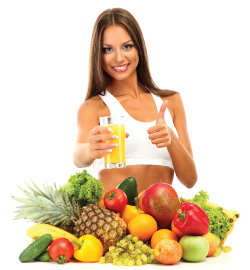This includes preventing foreign substances from entering the body; aiding in immune function; protecting internal organs from physical trauma; protecting against ultraviolet damage; regulating body temperature; producing lipids to protect and maintain hydration, thus preventing transepidermal water loss (TEWL) and dehydration; communicating sensations via touch, and excreting waste products and toxins. Another key function is synthesizing nutrients into molecules to provide each cell what it requires to do its job. Many of the micronutrients discussed play a significant role in collagen synthesis. Collagen is the most abundant protein in the body and comprises roughly 75 percent of the skin’s (dry) weight. It provides the dermis with its structural integrity and gives strength and tone to the skin and other tissues, hence reducing the appearance of wrinkles.
It should also be noted that the skin is an effective diagnostic tool to assess the body’s overall health. Internal factors that impact the body’s organs and systems also affect the skin; namely, how it looks and performs. Since the skin is connected to every part of the body, the health of the skin is indicative of the health within the body, and the health of the body depends on how we feed the skin. Think of it this way: food is an input and so are lifestyle choices. The body takes all these inputs collectively. So you cannot have a poor diet, carry high stress, get inadequate sleep and expect to maintain healthy skin. That is counterintuitive to the way the skin works. It is assumed that all the micronutrients have an effect on the skin in some way, however, in the interest of brevity, I will focus on the micronutrients that have a more direct connection to the skin via the functions listed above.
Vitamin A
Vitamin A is an umbrella term for an important class of antioxidants and is used to generically describe compounds that exhibit the biological activity of retinol, the alcoholic form of vitamin A. Vitamin A and its derivatives support cell growth and repair by reducing the oxidation of DNA, protecting cells from free radical damage, assisting with immune function, and maintaining and repairing epithelial tissue through cell differentiation and its role in gene expression. By affecting gene expression, vitamin A can determine what type of cell an immature cell will become. Protein cannot be utilized in the body without vitamin A.When protein is deficient, the amount of retinol-binding protein, (which binds to vitamin A and transports it from the liver to other tissues in the body), made is inadequate. Without vitamin A, epithelial cells which make up the skin cannot differentiate normally because there is no vitamin A to regulate the production of particular proteins. Because vitamin A increases cell proliferation and turnover, it is often used as a treatment for acne and wrinkles. Retinoids influence keratinocyte proliferation and differentiation via binding to nuclear retinoic acid receptors (RARalpha, -gamma) and retinoid X receptor alpha (RXRalpha). Carotenoids are compounds related to vitamin A and some can convert to retinol serving as precursors to vitamin A. Beta-carotene, among the most popular of the carotenoids, converts to retinyl esters in the epidermis. It also stimulates natural collagen and elastin. Once consumed, it converts to vitamin A in the liver but does not have the same effect as vitamin A in the body; hence, it does not pose the same toxic risk.
Vitamin B The B vitamins help to maintain the health of the nerves, skin, eyes, hair, liver, mouth, as well as healthy muscle tone in the gastrointestinal tract and proper brain function. They are essential for wound healing, prevention of premature skin aging and acne, aids new cell growth, and promotes circulation and metabolism. Because B vitamins work in tandem, a deficiency in one likely means a deficiency of another.
The B vitamins help to maintain the health of the nerves, skin, eyes, hair, liver, mouth, as well as healthy muscle tone in the gastrointestinal tract and proper brain function. They are essential for wound healing, prevention of premature skin aging and acne, aids new cell growth, and promotes circulation and metabolism. Because B vitamins work in tandem, a deficiency in one likely means a deficiency of another.
- Thiamine (B1) is responsible for the synthesis of neurotransmitters. Its function of breaking down glucose to provide energy is especially important since glucose is the energy source for nerve cells. Thiamine enhances circulation, plays a role in blood formation, carbohydrate metabolism, and aids digestion through the production of hydrochloric acid. This is worth noting because only about 20 percent of what the skin looks like is a result of topical ingredients. The other 80 percent, of which the dermis and subcutaneous layers are a part, is directly linked to how the body is fed and how nutrients are digested, absorbed, and utilized. As an antioxidant, thiamine protects the body from the degenerative effects of aging, alcohol consumption, and smoking. Its link to acne is twofold. First, its responsibility to breakdown carbohydrates and sugar is significant since too much sugar would lead to too much insulin circulating in the blood. Insulin would stimulate the overproduction of other hormones which could cause an increase in sebum production and acne. Also, excessive sugar is inflammatory and can cause glycation and wrinkles due to the degradation of collagen. Secondly, thiamine is considered an anti-stress vitamin as it supports the immune system and seems to improve the body’s ability to cope during stressful situations.
- Riboflavin (B2) is responsible for DNA replication and repair. It facilitates the use of oxygen by the tissues of the skin, hair, and nails and eliminates dandruff. It is required for red blood cell production and cell respiration. Together with vitamin A, it maintains and improves the mucous membranes in the digestive tract. Deficiency can lead to cracks and sores at the corners of the mouth, skin lesions and dermatitis, poor digestion, and hair loss.
- Niacin (B3) improves circulation and is essential for healthy skin. It is essential in glucose metabolism, fatty acid and cholesterol synthesis, and in the production of hydrochloric acid. Skin lesions, inflammation, and dermatitis are directly linked to a deficiency in niacin.
- Pantothenic acid (B5) is also considered an anti-stress vitamin and is required by every cell in the body. It is needed for proper adrenal gland function and plays a vital role in the production of adrenal hormones and neurotransmitters. As discussed above, the adrenal glands release androgens and can ultimately promote acneic conditions in the skin.
- Pyridoxine (B6) is required to make hemoglobin, which transports oxygen in the blood. It affects nerve transmission by synthesizing lipids that are part of the myelin sheath that coats nerves. Myelin is essential for nerve transmission. It synthesizes hemoglobin, converts tryptophan into niacin, and breaks down glycogen to release glucose into the blood. It is also needed to form white blood cells which impact the skin’s immune function. Deficiency can lead to flaky skin, impaired wound healing, facial oiliness, numbness, and tingly sensations.
- Cobalamin (B12) is necessary to maintain the myelin coating on nerves and is necessary for the production of adenosine triphosphate (ATP) – the energy required for each cell in the body to perform. As is the case with all other B vitamins, it would be impossible for the body to exist without it, as it is required for proper digestion, absorption, protein synthesis, carbohydrate and fat metabolism. It aids in cell formation and cellular longevity.
- Folate (folic acid) is needed for DNA synthesis. Cells must synthesize DNA in order to replicate which is vital to maintain the integrity of the skin which sheds its cells so rapidly. Without folate developing, red blood cells cannot divide and grow bigger, reducing the blood’s oxygen carrying capacity. It also supports the immune system by aiding in the formation and function of white blood cells.
- Biotin functions in energy metabolism and glucose synthesis. It acts via cell surface receptors to regulate the expression of key enzymes involved in glucose metabolism. It is also important for the metabolism of fatty acids and amino acids which are primary components of the cell membrane and necessary for healthy skin. Biotin deficiency often results in seborrheic dermatitis characterized by scaly, flaky, itchy, red skin.
 Vitamin C
Vitamin C
Vitamin C is a powerful antioxidant that “brightens, lightens, and tightens.” It is considered a powerhouse vitamin for the skin. It helps prevent water loss and maintains the skin’s barrier function; it strengthens capillary walls; promotes collagen and elastin synthesis; helps to brighten and prevent photo-damage; and increases cell proliferation. Vitamin C is a wound-healing vitamin, as it is required for tissue growth and repair. It is used to combat the effects of environmental stressors (ultraviolet rays, including UVA and UVB damage) and toxins, and deactivates free radicals. It can inhibit irregular melanin production, thereby reducing melanogenesis, and suppresses hyperpigmentation and inflammation, making it an important weapon for acne patients. The ability to fight infection is diminished when vitamin C is deficient. Vitamin C inhibits collagenase to suppress collagen degradation, as well as inhibits the activity of matrix metalloproteinases (MMPs), often referred to as aging enzymes, which can break down collagen. According to the Linus Pauling Institute, vitamin C is found at high levels in both the epidermis and dermis, however, the vitamin C content in the epidermis is higher than in the dermis but diminishes with age. By some accounts, there is as much as five times more vitamin C in the epidermis than the deeper layers of the skin.
Vitamin D
Vitamin D regulates the processes of cell prolifera-tion and differentiation that takes place in the basal layer of the epidermis ultimately supporting cell growth, wound healing, and maintaining the skin’s barrier functions. The active form of vitamin D appears to have an indirect effect on wound healing properties of the skin by regulating the expression of cathelicidin, an antimicrobial protein which promotes wound healing and tissue repair. Cathelicidin modulates inflammation in skin, induces angiogenesis and improves re-epithelialization (the process of restoring the epidermal barrier to re-establish a functional barrier that protects underlying cells from environmental exposures). There is a growing body of evidence that vitamin D3 is an important regulator of cutaneous immunity, in addition to its role in calcium homeostasis and bone metabolism. In particular, vitamin D3 exerts pluripotent effects on adaptive immune functions such as T cell activation and maturation of dendritic cells. In addition, vitamin D3 has been suggested to increase innate immunity in skin and to enable efficient antimicrobial defense at epithelial surfaces.
Vitamin E
Vitamin E is another powerful antioxidant that promotes healthy skin. It improves circulation, is necessary for tissue repair, and protects cell membranes. It prevents cell damage by inhibiting the oxidation of lipids. Vitamin E helps prevent sun damage by absorbing the energy from ultraviolet light, although it cannot absorb UVA light. According to the Pauling Institute, vitamin E is the most abundant lipophilic antioxidant found in human skin. Like vitamin C, levels of vitamin E in the epidermis are higher than in the dermis. Vitamin E first accumulates in the sebaceous glands before it is delivered to the skin surface through sebum. Following oral ingestion, it takes at least seven days before the vitamin E content of sebum is altered. There are no transport proteins specific for vitamin E in the skin. Due to its lipophilic nature, vitamin E can also penetrate into all underlying layers of skin.
 Vitamin K
Vitamin K
Vitamin K is needed for the normal clotting of blood. It is useful in healing skin discolorations, as well as treating under-eye darkness and circles. It is vitamin K’s blood clotting function that makes it a good choice for preventing bruising and hemorrhaging. Research suggests vitamin K activates the protein Matrix-carboxyglatamic acid (MGP) that inhibits the calcification of the skin leading to wrinkles in people suffering from a genetic disease- pseudoxanthoma elasticum (PXE) which causes severe wrinkling on the face and body.
Other Micronutrients
Coenzyme Q10 aids circulation, stimulates the immune system, increases tissue oxygenation, and has anti-aging benefits.
Boron is necessary for the metabolism of calcium, phosphorus, and magnesium. It is needed for healthy bones and muscle growth which supports healthy skin tone. Boron also plays a role in how the body uses energy from fats and sugars.
Calcium is needed for muscle growth and contraction; is essential in blood clotting; plays a role in fat metabolism through the activation of lipase; maintains proper cell membrane permeability; release of neurotransmitters, and helps keep skin healthy. Cellular calcium concentrations can control biological activity by facilitating the conversion of inactive proenzymes to active enzymes. Specific to the skin, a deficiency in calcium can lead to eczema and other cases of xerosis (dry skin).
Chromium is required to maintain normal blood glucose levels and is needed for energy. It is believed to act by enhancing the effects of insulin and through proper insulin utilization. It is essential for the synthesis of cholesterol, fats, and proteins. A deficiency is associated with glucose intolerance and inadequate metabolism of amino acids. Excessive intake has been linked to dermatitis.
"There is as much as five times more vitamin C in the epidermis than the deeper layers of the skin."
Copper is linked to collagen synthesis. If there is too little copper in the body, copper does not form normally, resulting in skeletal changes similar to those seen in vitamin C deficiency. Copper also aids in the formation of hemoglobin and red blood cells, as well as works with zinc and vitamin C to form elastin which provides elasticity and flexibility to the skin.
Iodine is needed for the proper functioning of the thyroid gland and ultimately every cell in the body. Thyroid hormones regulate metabolic rate, allowing each cell to do more of what it does; growth and development, and protein synthesis. Iodine aids in healing skin infections, prevents roughness and premature wrinkling.
Iron is associated with oxygen. The most important function is in the production of hemoglobin and the oxygenation of red blood cells and myoglobin found in muscle tissue. Iron is important to a healthy immune system and for energy production.
Magnesium assists in the uptake of calcium and potassium and the production of adenosine triphosphate. It is needed in every metabolic reaction that generates or uses adenosine triphosphate – every cell in the body. Magnesium helps regulate calcium homeostasis and the action of vitamin D.
Manganese is involved in collagen synthesis and degradation; gluconeogenesis and glucose regulation. Manganese is required for the activation of prolidase, an enzyme that functions to provide the amino acid proline for collagen formation.
Phosphorous is needed for blood clotting. In the body there should always be a balance of calcium, magnesium, and phosphorus. Phosphorous is a structural component of the phospholipid bilayer that makes up cell membranes, DNA and RNA, and is important in energy metabolism in the cells.
Potassium works with sodium to control the body’s water balance. Low potassium levels can lead to intracellular water loss, causing dry skin and dehydration. Dehydration leads to the death of cells and a degradation of the skin.
Selenium is part of the antioxidant enzyme glutathione peroxidase. It is also part of a protein needed for the synthesis of thyroid hormones and plays a vital role in regulating the effects of thyroid hormone on fat metabolism. But the primary function of selenium is to inhibit the oxidation of fats. Symptoms of selenium deficiency can include skin eruptions.
Sodium regulates fluid volume, ion transport, and intracellular osmotic pressure which directly affect edema in the skin and tissues. Inadequate sodium levels can lead to intracellular water loss and dysfunction in cellular communication, function, and so on.
Sulfur helps keep skin clear and smooth and is often used for the treatment of acne. Sulfur is needed for protein synthesis because methionine and cysteine both contain sulfur and is needed to build proteins.
Zinc aids in wound healing, promotes cell growth and immune function. Zinc is often combined with vitamin A in the treatment of acne. Zinc is needed by enzymes involved in the synthesis of DNA and RNA, carbohydrate metabolism, and facilitates the absorption of folate from food. Zinc supports the storage and release of insulin and the mobilization of vitamin A from the liver.
References
1 Balch, P. (2000). Prescription for nutritional healing, 3rd ed.
2 Gheduzzi, D., Boraldi, F., Annovi, G., Paolinelli DeVincenzi, C., Schurgers, L., Vermeer, C.,
3 Quaglino, D., & Pasquali Ronchetti, I. (2007). Matrix Gla protein is involved in elastic fiber calcification in the dermis of pseudoxanthoma elasticum patients. Laboratory Investigation. 87:998–1008. doi:10.1038/labinvest.3700667
4 Gibney, M., Lanham-New, S., Cassidy, A., & Vorster, H., (Eds.). (2009). Introduction to human nutrition, 2nd ed. West
Sussex: Wiley.
5 Grosvenor, M., & Smolin, L., (2012). Visualizing Nutrition: Everyday choices, 2nd ed. Hoboken: Wiley.
6 Karlsson T., Vahlquist A., & Törmä H. (2010). Keratinocyte Differentiation Induced by Calcium, Phorbol Ester or Interferon-Gamma Elicits Distinct Changes in the Retinoid Signalling Pathways. Journal of Dermatological Science.
7 Linus Pauling Institute. (2011). Vitamin D and Skin Health. Oregon State University: Drake, V., Ph.D. Retrieved from http://lpi.oregonstate.edu/infocenter/skin/vitaminD/
index.html
8 Linus Pauling Institute. (2012). Vitamin E and Skin Health. Oregon State University: Michels,
9 A., Ph.D. Retrieved from http://lpi.oregonstate.edu/infocenter/skin/vitaminE/index.html
Linus Pauling Institute. (2011). Vitamin C and Skin Health. Oregon State University: Michels,
10 A., Ph.D. Retrieved from http://lpi.oregonstate.edu/infocenter/skin/vitaminC/index.html
11 Schauber, J. & Gallo, R. (2008). The vitamin D pathway: a new target for control of the skin’s immune response? Experimental Dermatology. 17(8):633-639. doi: 10.1111/j.1600-0625.2008.00768.x
12 Stipanuk, M., & Caudill. (2012). Biological, physiological, and molecular aspects of human nutrition, 3rd ed. St. Louis:
Elsevier Saunders.
13 Tourles, S. (1999). Naturally healthy skin: Tips and techniques for a lifetime of radiant
 Tasha D. Manigo-Bizzell, L.E., MBA, IHP, MS, is a licensed aesthetician, makeup artist, Maryland State Trainer for the Look Good…Feel Better program, and “Esteem Coach.” She received her BS and MBA degrees in Marketing; and a MS degree in Nutrition and Integrative Health. She has been active in the health and wellness industry for more than 16 years as an educator, writer, guest lecturer, and consultant. Through her outreach program she uses esthetic and nutrition education to inspire women and girls who have struggled feeling beautiful in their bodies. This email address is being protected from spambots. You need JavaScript enabled to view it.
Tasha D. Manigo-Bizzell, L.E., MBA, IHP, MS, is a licensed aesthetician, makeup artist, Maryland State Trainer for the Look Good…Feel Better program, and “Esteem Coach.” She received her BS and MBA degrees in Marketing; and a MS degree in Nutrition and Integrative Health. She has been active in the health and wellness industry for more than 16 years as an educator, writer, guest lecturer, and consultant. Through her outreach program she uses esthetic and nutrition education to inspire women and girls who have struggled feeling beautiful in their bodies. This email address is being protected from spambots. You need JavaScript enabled to view it.
